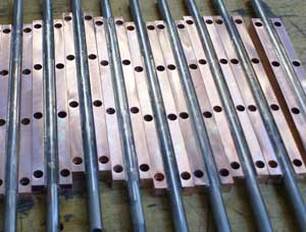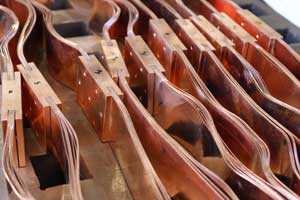Call: 708-425-9080
Selecting a Braze Filler Metal
This is a technical informational article. Meyer Tool is not a manufacturer or distributor of braze filler materials.
 Copper-SSTL brazing
Copper-SSTL brazing
In our April 2012 newsletter we discussed the use of Brazed Joints at the Vacuum Boundary. Subsequently we’ve been asked about how to choose the correct braze filler metal for particular brazing operations. Herein we will attempt to give some general guidelines for making this selection.
Brazing is a metal joining process in which base metals are joined without exceeding their melting temperature using a braze filler metal melted at a temperature above 840°F. The braze filler metal wets the base metal surfaces and is drawn or held in the joint by capillary action. The American Welding Society (AWS) defines brazing filler metal rather simply as “the metal added when making a braze; with a melting point above 840°F and below that of the base metals to be joined”. Braze filler metals are classified by their chemical composition. The AWS and the ASME Code utilize the same classification system to characterize brazing filler metals by their chemical composition. They define eight classifications:
Brazing is a metal joining process in which base metals are joined without exceeding their melting temperature using a braze filler metal melted at a temperature above 840°F. The braze filler metal wets the base metal surfaces and is drawn or held in the joint by capillary action. The American Welding Society (AWS) defines brazing filler metal rather simply as “the metal added when making a braze; with a melting point above 840°F and below that of the base metals to be joined”. Braze filler metals are classified by their chemical composition. The AWS and the ASME Code utilize the same classification system to characterize brazing filler metals by their chemical composition. They define eight classifications:
- Aluminum-silicon (AlSi)
- Copper-phosphorus (CuP)
- Silver (Ag)
- Precious metals (Au)
- Copper and copper-zinc (Cu and CuZn)
- Magnesium (Mg)
- Nickel (Ni)
- Cobalt (Co)
 Copper brazing
Copper brazing
The nomenclature for identifying a particular braze filler metal is simple: B(Chemical Composition identifier)-(filler number/letter). For example the lowest liquidus temperature silver braze filler metal is identified as BAg-1, while the highest liquidus temperature nickel braze filler metal is identified as BNi-14.
When selecting a braze filler metal important factors to consider are:
We caution that this is an overview article and not every nuance is explored. Whole books have been written on this subject and for those researching an application we strongly suggest starting with the AWS Brazing Handbook for a more comprehensive treatment.
Base metals being joined
Each of the braze filler metals is formulated for use with specific base metals and combinations of base metals. The following is a basic but not comprehensive summary.
Brazing Process
We discuss the three most common brazing processes in Brazed Joints at the Vacuum Boundary. Each of the braze filler classifications and specific fillers within the classifications have preferred methods and limitations. The silver alloys are again the most versatile with most filler metals being suitable for any process (except dip brazing).
Brazing Temperature
Brazing temperature is limited by the base metals being joined. Remember brazing is defined as a process that takes place below the melting point of the base metals. Within the braze filler classifications the specific filler metals are alloyed to provide a range of solidus and liquidus temperatures. Eutectic filler metals are formulated to melt at one temperature. Process selection and joint design can take advantage of the solidus and liquidus range for braze fillers especially in manually brazed, relatively large gap joint designs. Situations where components must be step brazed, i.e. brazing joints made in sequence using lower temperature braze fillers to maintain the integrity of previously brazed joints, require close review of temperature ranges.
Applying the Filler Metal to the Joint
There are a limited number of ways the braze filler metal can be introduced between the base metal faying surfaces. They may be pre-placed prior to heating to flow into the joint, pre-placed prior to heating in the joint, or manually face fed after heating. The joint design and brazing process will drive the selection of how to apply the filler metal.
Design of the Joint
There are only two basic braze joint types, the butt joint and lap joint. The braze process selected and the base metals used will inform the specific clearance and configuration of the joint. All joint designs should use correct clearances (taking into account coefficients of thermal expansion for dissimilar metals), proper machining details to avoid the formation of flux traps within the joint, and provision for venting of brazing gasses and the flow of flux out of the joint. Ideally a joint design that allows visual confirmation that the braze filler metal has completely flowed through the joint is desired.
Braze Filler Available Form
Braze filler metals are available in rods, sheet, powder, wire in coils, and pre-made forms specifically designed for a particular joint. The availability of a specific size and form will vary from classification to classification and manufacturer. For most common applications, e.g. face feed torch brazing or pre-assembled furnace brazing, the form needed will be available. In fact, the issue may be the number of choices rather than the lack of choices. The joint design and brazing process will drive the selection of the form and size of the filler metal.
Environment and Service
Brazing handbooks provide information on the use of braze filler metals in common environments and services such as high vacuum or corrosive environments. Define your conditions, then review the selected braze filler metal classification for the most suitable chemical composition for those conditions. For example, BAg-1, an economical low silver braze filler suitable for copper to stainless steel joints, contains cadmium and should be avoided in high vacuum or ultra-high vacuum environments due to the outgassing of the cadmium.
Final Selection
The selection of a braze filler metal is predicated upon the choices made in addressing the above factors. Conversely, choosing a braze filler metal to meet the needs of the base metal and service requirements first will drive the selection of the process, application, joint design, and form. Determining how to make these choices and understanding their implications is how Meyer Tool keeps our promise to Reduce Project Risk and help you achieve the lowest total cost of ownership for your project.
When selecting a braze filler metal important factors to consider are:
- The base metals being joined.
- The brazing process to be used.
- The brazing temperature.
- How the braze filler metal is applied to the joint.
- The design of the joint.
- What form the braze filler is available in.
- The environment and service of the joint.
We caution that this is an overview article and not every nuance is explored. Whole books have been written on this subject and for those researching an application we strongly suggest starting with the AWS Brazing Handbook for a more comprehensive treatment.
Base metals being joined
Each of the braze filler metals is formulated for use with specific base metals and combinations of base metals. The following is a basic but not comprehensive summary.
- Aluminum-silicon (BAlSi-X): Used for joining aluminum and aluminum alloys.
- Copper-phosphorus (BCuP-X): Primarily for copper to copper joints, with some limited use on silver, tungsten, and molybdenum. They should not be used on ferrous, nickel, or copper/nickel alloys containing more than 10% nickel.
- Silver (BAg-X): The most versatile classification, silver based fillers are used for joining most ferrous and non-ferrous metals except for aluminum and magnesium alloys.
- Precious metals (BAu-X): Used for brazing iron, nickel and cobalt-base metals, but we also see their use in copper/stainless steel applications.
- Copper and copper-zinc (BCu-X and BCuZn-X): This classification is generally used for joining a variety of ferrous and non-ferrous metals. The fillers containing zinc are not recommended for joining copper, silicon bronze, copper-nickel or stainless steel.
- Magnesium (BMg-X): Used for joining magnesium based alloys.
- Nickel (BNi-X): Used for corrosion and heat resistant properties, these filler metals are used for joining stainless steels, nickel-based alloys, cobalt-base alloys, carbon steel, and copper.
- Cobalt (BCo-X): Used for their high temperature properties with cobalt-based base metals.
Brazing Process
We discuss the three most common brazing processes in Brazed Joints at the Vacuum Boundary. Each of the braze filler classifications and specific fillers within the classifications have preferred methods and limitations. The silver alloys are again the most versatile with most filler metals being suitable for any process (except dip brazing).
Brazing Temperature
Brazing temperature is limited by the base metals being joined. Remember brazing is defined as a process that takes place below the melting point of the base metals. Within the braze filler classifications the specific filler metals are alloyed to provide a range of solidus and liquidus temperatures. Eutectic filler metals are formulated to melt at one temperature. Process selection and joint design can take advantage of the solidus and liquidus range for braze fillers especially in manually brazed, relatively large gap joint designs. Situations where components must be step brazed, i.e. brazing joints made in sequence using lower temperature braze fillers to maintain the integrity of previously brazed joints, require close review of temperature ranges.
Applying the Filler Metal to the Joint
There are a limited number of ways the braze filler metal can be introduced between the base metal faying surfaces. They may be pre-placed prior to heating to flow into the joint, pre-placed prior to heating in the joint, or manually face fed after heating. The joint design and brazing process will drive the selection of how to apply the filler metal.
Design of the Joint
There are only two basic braze joint types, the butt joint and lap joint. The braze process selected and the base metals used will inform the specific clearance and configuration of the joint. All joint designs should use correct clearances (taking into account coefficients of thermal expansion for dissimilar metals), proper machining details to avoid the formation of flux traps within the joint, and provision for venting of brazing gasses and the flow of flux out of the joint. Ideally a joint design that allows visual confirmation that the braze filler metal has completely flowed through the joint is desired.
Braze Filler Available Form
Braze filler metals are available in rods, sheet, powder, wire in coils, and pre-made forms specifically designed for a particular joint. The availability of a specific size and form will vary from classification to classification and manufacturer. For most common applications, e.g. face feed torch brazing or pre-assembled furnace brazing, the form needed will be available. In fact, the issue may be the number of choices rather than the lack of choices. The joint design and brazing process will drive the selection of the form and size of the filler metal.
Environment and Service
Brazing handbooks provide information on the use of braze filler metals in common environments and services such as high vacuum or corrosive environments. Define your conditions, then review the selected braze filler metal classification for the most suitable chemical composition for those conditions. For example, BAg-1, an economical low silver braze filler suitable for copper to stainless steel joints, contains cadmium and should be avoided in high vacuum or ultra-high vacuum environments due to the outgassing of the cadmium.
Final Selection
The selection of a braze filler metal is predicated upon the choices made in addressing the above factors. Conversely, choosing a braze filler metal to meet the needs of the base metal and service requirements first will drive the selection of the process, application, joint design, and form. Determining how to make these choices and understanding their implications is how Meyer Tool keeps our promise to Reduce Project Risk and help you achieve the lowest total cost of ownership for your project.



